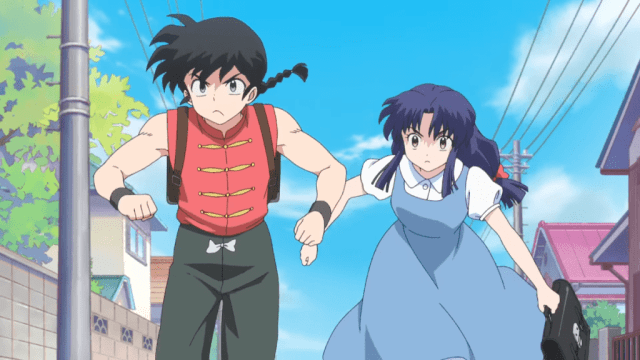Sixteen-year-old Akane Tendo loves martial arts and hates men, so when her father decides it’s time to marry her off to secure the future of their dojo, she’s naturally pissed off. But her outlook changes the instant she meets her betrothed, Ranma Saotome, who actually happens to be a woman … well, sort of.
In fact, Ranma is a boy who’s been cursed to turn into a girl any time he is hit by cold water, and can only become a boy again if hit with hot water. This should be a boon for Akane, her sisters insist, since she detests boys, and Ranma is ‘already half girl anyway!’
In very Shakespearean fashion, Ranma quickly gains admirers in both girl and boy form, only to confuse or disappoint them when he transforms into the other sex. Enemies start to emerge, too, but it’s worth noting the majority of them are also scorned lovers. In both camps there are also quite a few cross-dressers (the term used at the time, before more nuanced ways of looking at gender came into popularity). It’s all so … queer!
Thus begins one of the most beloved anime and manga series of all time, Ranma ½ (verbalised as Ranma One-Half), created by Rumiko Takahashi in 1987. Adapted into an anime first in the 80s, and now again in the 2020s, Ranma ½ is one of those stories that could have easily become laughable for its outdated gender norms – instead, the (sometimes intentional, sometimes not) exploration of personal expression and sexual identity continues to gain more significance as we shift into a more accepting world.
Ranma ½ obviously resonated with queer folk for its early depictions of gender non-conformity in mainstream anime. As the series progresses, Ranma decides to willfully transform into a girl when it can advance his goals, or simply improve his mood. It’s easy to see how a character like that can appeal to the transgender, gender fluid, gender queer, and non-binary folk among us.
And it’s not just him. There’s also Ukiyo, a girl that attends a boy’s school and dresses in ‘masculine’ clothing, and Tsubasa, a boy who wears dresses and other traditionally feminine garb, but still identifies as a straight man.
ScreenHub: Drag Race Down Under: Stan reveals new queens
Yes, a lot of the characters are either fetishised or played for laughs, framing the characters as absurd for their behaviour (I mean, it was the 80s), but beneath that frame lies the chance to get these kinds of fluid, binary-breaking identities past the Japanese TV censors. LGBTQIA+ issues are still quite misunderstood and outright taboo in Japan (and, well, just about everywhere else), so the fact that a show like this A: exists and B: is so enormously popular is quite a miracle.

Death of the author?
A lot of its significance also lies in how the story is read by the audience. In this case, the outcome trumps the intention. While I can’t speak for Japanese audiences, I know that both the manga and anime are among the first in their respective media to have become popular in the United States. That means that, for the Western world, many people’s introduction to Japanese animation was via Ranma ½. There are now many accounts from Western fans who credit Ranma ½ with ‘cracking their egg‘, or giving them confidence to experiment with their gender expression.
For many viewers, as Ranma and Akane bicker, spar, and eventually for one another under the roof of the Tendo ‘Anything Goes’ martial arts dojo, the LGBTQIA+ themes become more and more obvious, until restrictive gender binaries could be argued moot. I’m sure I’m not the only one who watched the original Ranma ½ and wished desperately to have the ability to change sexes on a whim. That’s the genderfluid dream!
The Netflix remake
Now that we’re in a time where the spectrums of sexuality and gender are both much better understood, Netflix and MAPPA studios have decided to remake the beloved series, with its first episode debuting last week (6 October 2024). The first change that’s obvious is the updated animation, which displays more advanced colouring, movement and character detail (in other words, it looks great).
There are also subtle character changes – Ranma appears bashful as both a boy and a girl, not just in his girl form (as it was in the past). Akane is also more outwardly defiant of gender and sexuality norms. ‘It was different’ when Ranma was a girl, she says.
All the fan favourite characters are there, including Ranma’s father, who is cursed to turn into a panda when hit with cold water. There sure are a lot of curses in this world! And aside from all the boundary-breaking gender stuff, I can’t wait to watch Akane and Ranma fall in love again. They’re so darn cute!
ScreenHub: Netflix: the 5 best films to stream right now
Time will tell if this remake dares to be more nuanced in its take on the gender-bending hero, or if it will simply play it straight. The former would be really interesting, but the latter would mean the original intention is kept intact so that modern audiences can study it as a ‘product of its time’ (the original anime is not readily available to watch anywhere). Either way, there’s never been a better time to get into Ranma ½. The series will forever be iconic for showing that, when it comes to gender, ‘anything goes!’
I’ll now leave you with this clip from the original Ranma ½ anime that always makes me crack up. Enjoy!
Ranma ½ is now streaming on Netflix.





